Sustainable Supply Chain Management Overview
VerifiedAdded on 2020/05/08
|13
|3157
|105
AI Summary
This assignment delves into the crucial topic of Sustainable Supply Chain Management. It presents various theoretical perspectives, practical frameworks, and examples of successful implementations. Students will gain insights into key concepts, challenges, and opportunities associated with integrating sustainability throughout the supply chain.
Contribute Materials
Your contribution can guide someone’s learning journey. Share your
documents today.
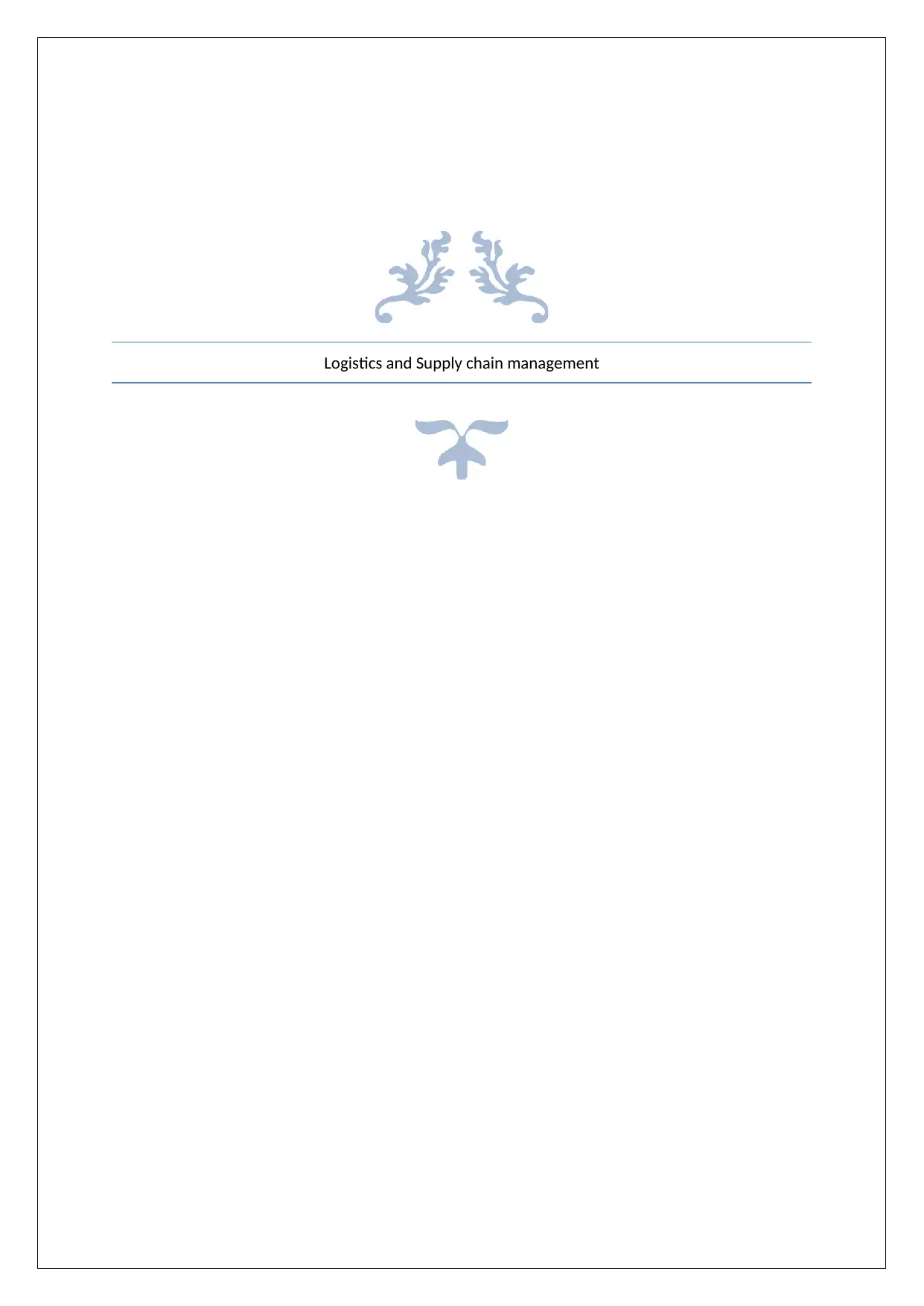
Logistics and Supply chain management
Secure Best Marks with AI Grader
Need help grading? Try our AI Grader for instant feedback on your assignments.

Running Head: Report
Contents
Section 1.......................................................................................................................2
Forecasting................................................................................................................2
Third party logistics................................................................................................... 3
Humanitarian Logistics...............................................................................................3
Using Information Technology (IT) in Logistics and Supply Chain Management.............4
Case study 1..................................................................................................................6
Activities undertaken by IKEA to ensure the sustainability of their supply chain..............6
Present impact and future implications of the sustainable sourcing and supply practices....7
Case study 2..................................................................................................................8
Improvement in the efficiency and effectiveness of IKEA’s logistics and supply chain
management.............................................................................................................. 8
Assurance of end to end customer satisfaction...............................................................9
References.................................................................................................................. 11
1
Contents
Section 1.......................................................................................................................2
Forecasting................................................................................................................2
Third party logistics................................................................................................... 3
Humanitarian Logistics...............................................................................................3
Using Information Technology (IT) in Logistics and Supply Chain Management.............4
Case study 1..................................................................................................................6
Activities undertaken by IKEA to ensure the sustainability of their supply chain..............6
Present impact and future implications of the sustainable sourcing and supply practices....7
Case study 2..................................................................................................................8
Improvement in the efficiency and effectiveness of IKEA’s logistics and supply chain
management.............................................................................................................. 8
Assurance of end to end customer satisfaction...............................................................9
References.................................................................................................................. 11
1
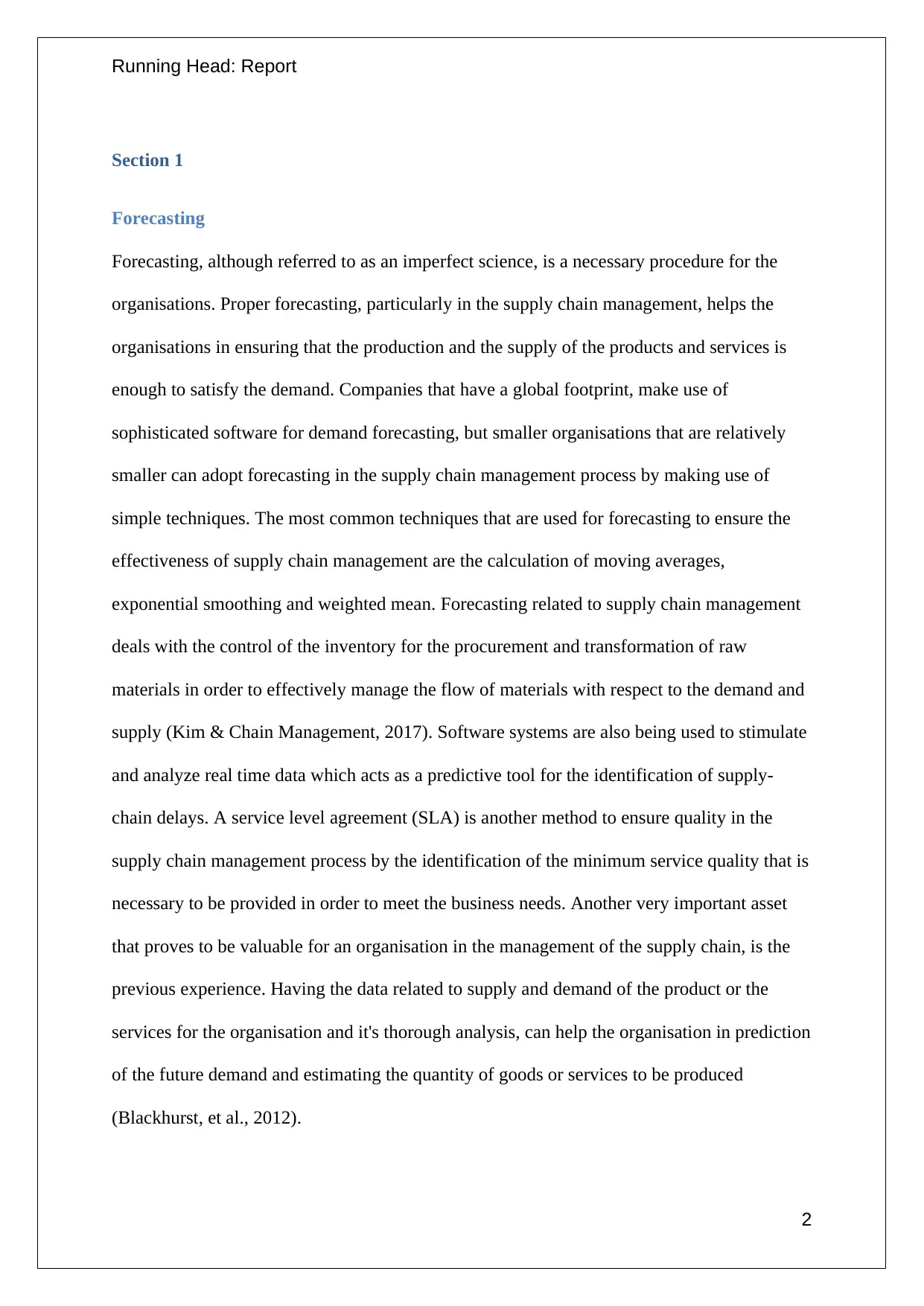
Running Head: Report
Section 1
Forecasting
Forecasting, although referred to as an imperfect science, is a necessary procedure for the
organisations. Proper forecasting, particularly in the supply chain management, helps the
organisations in ensuring that the production and the supply of the products and services is
enough to satisfy the demand. Companies that have a global footprint, make use of
sophisticated software for demand forecasting, but smaller organisations that are relatively
smaller can adopt forecasting in the supply chain management process by making use of
simple techniques. The most common techniques that are used for forecasting to ensure the
effectiveness of supply chain management are the calculation of moving averages,
exponential smoothing and weighted mean. Forecasting related to supply chain management
deals with the control of the inventory for the procurement and transformation of raw
materials in order to effectively manage the flow of materials with respect to the demand and
supply (Kim & Chain Management, 2017). Software systems are also being used to stimulate
and analyze real time data which acts as a predictive tool for the identification of supply-
chain delays. A service level agreement (SLA) is another method to ensure quality in the
supply chain management process by the identification of the minimum service quality that is
necessary to be provided in order to meet the business needs. Another very important asset
that proves to be valuable for an organisation in the management of the supply chain, is the
previous experience. Having the data related to supply and demand of the product or the
services for the organisation and it's thorough analysis, can help the organisation in prediction
of the future demand and estimating the quantity of goods or services to be produced
(Blackhurst, et al., 2012).
2
Section 1
Forecasting
Forecasting, although referred to as an imperfect science, is a necessary procedure for the
organisations. Proper forecasting, particularly in the supply chain management, helps the
organisations in ensuring that the production and the supply of the products and services is
enough to satisfy the demand. Companies that have a global footprint, make use of
sophisticated software for demand forecasting, but smaller organisations that are relatively
smaller can adopt forecasting in the supply chain management process by making use of
simple techniques. The most common techniques that are used for forecasting to ensure the
effectiveness of supply chain management are the calculation of moving averages,
exponential smoothing and weighted mean. Forecasting related to supply chain management
deals with the control of the inventory for the procurement and transformation of raw
materials in order to effectively manage the flow of materials with respect to the demand and
supply (Kim & Chain Management, 2017). Software systems are also being used to stimulate
and analyze real time data which acts as a predictive tool for the identification of supply-
chain delays. A service level agreement (SLA) is another method to ensure quality in the
supply chain management process by the identification of the minimum service quality that is
necessary to be provided in order to meet the business needs. Another very important asset
that proves to be valuable for an organisation in the management of the supply chain, is the
previous experience. Having the data related to supply and demand of the product or the
services for the organisation and it's thorough analysis, can help the organisation in prediction
of the future demand and estimating the quantity of goods or services to be produced
(Blackhurst, et al., 2012).
2
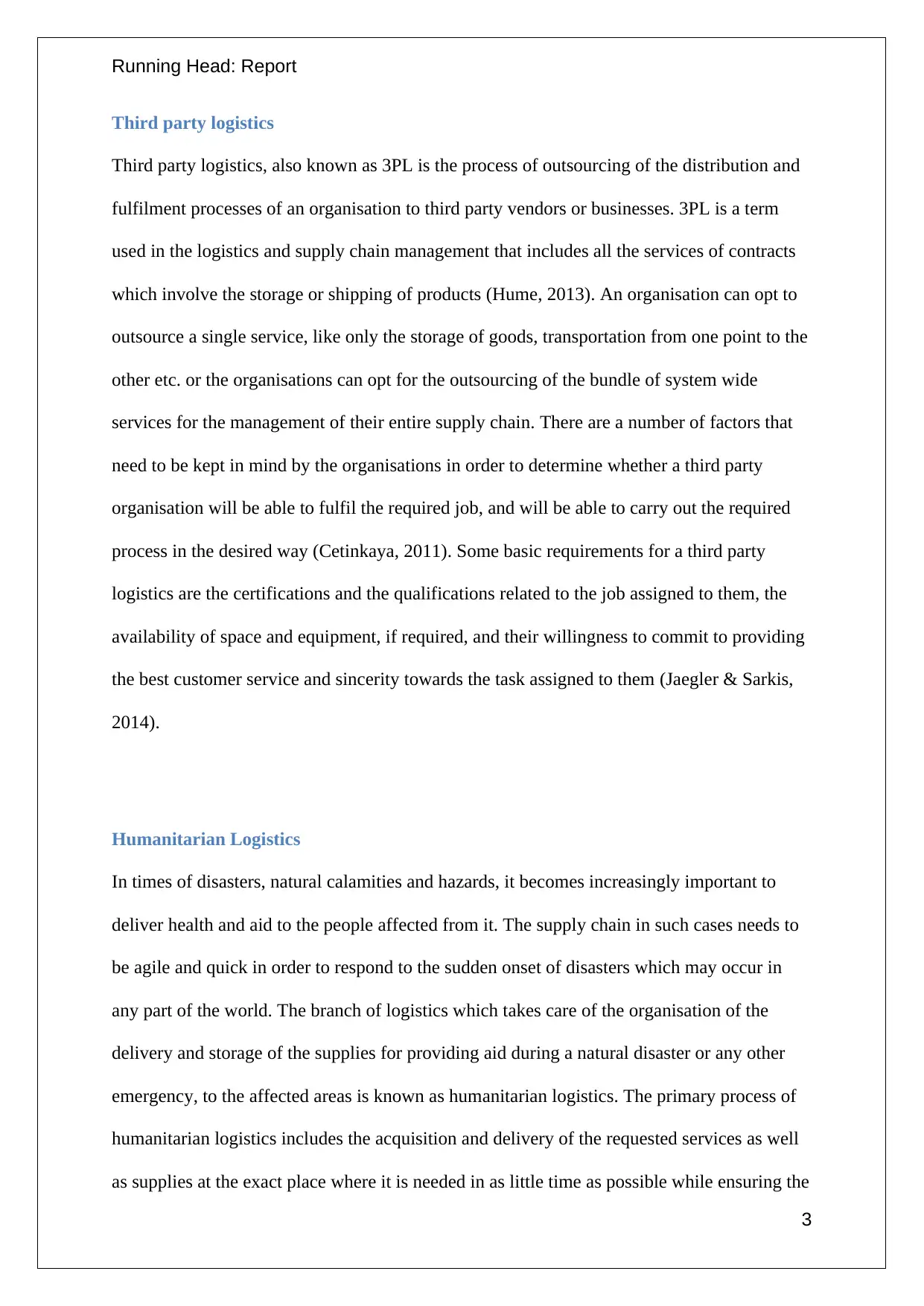
Running Head: Report
Third party logistics
Third party logistics, also known as 3PL is the process of outsourcing of the distribution and
fulfilment processes of an organisation to third party vendors or businesses. 3PL is a term
used in the logistics and supply chain management that includes all the services of contracts
which involve the storage or shipping of products (Hume, 2013). An organisation can opt to
outsource a single service, like only the storage of goods, transportation from one point to the
other etc. or the organisations can opt for the outsourcing of the bundle of system wide
services for the management of their entire supply chain. There are a number of factors that
need to be kept in mind by the organisations in order to determine whether a third party
organisation will be able to fulfil the required job, and will be able to carry out the required
process in the desired way (Cetinkaya, 2011). Some basic requirements for a third party
logistics are the certifications and the qualifications related to the job assigned to them, the
availability of space and equipment, if required, and their willingness to commit to providing
the best customer service and sincerity towards the task assigned to them (Jaegler & Sarkis,
2014).
Humanitarian Logistics
In times of disasters, natural calamities and hazards, it becomes increasingly important to
deliver health and aid to the people affected from it. The supply chain in such cases needs to
be agile and quick in order to respond to the sudden onset of disasters which may occur in
any part of the world. The branch of logistics which takes care of the organisation of the
delivery and storage of the supplies for providing aid during a natural disaster or any other
emergency, to the affected areas is known as humanitarian logistics. The primary process of
humanitarian logistics includes the acquisition and delivery of the requested services as well
as supplies at the exact place where it is needed in as little time as possible while ensuring the
3
Third party logistics
Third party logistics, also known as 3PL is the process of outsourcing of the distribution and
fulfilment processes of an organisation to third party vendors or businesses. 3PL is a term
used in the logistics and supply chain management that includes all the services of contracts
which involve the storage or shipping of products (Hume, 2013). An organisation can opt to
outsource a single service, like only the storage of goods, transportation from one point to the
other etc. or the organisations can opt for the outsourcing of the bundle of system wide
services for the management of their entire supply chain. There are a number of factors that
need to be kept in mind by the organisations in order to determine whether a third party
organisation will be able to fulfil the required job, and will be able to carry out the required
process in the desired way (Cetinkaya, 2011). Some basic requirements for a third party
logistics are the certifications and the qualifications related to the job assigned to them, the
availability of space and equipment, if required, and their willingness to commit to providing
the best customer service and sincerity towards the task assigned to them (Jaegler & Sarkis,
2014).
Humanitarian Logistics
In times of disasters, natural calamities and hazards, it becomes increasingly important to
deliver health and aid to the people affected from it. The supply chain in such cases needs to
be agile and quick in order to respond to the sudden onset of disasters which may occur in
any part of the world. The branch of logistics which takes care of the organisation of the
delivery and storage of the supplies for providing aid during a natural disaster or any other
emergency, to the affected areas is known as humanitarian logistics. The primary process of
humanitarian logistics includes the acquisition and delivery of the requested services as well
as supplies at the exact place where it is needed in as little time as possible while ensuring the
3
Secure Best Marks with AI Grader
Need help grading? Try our AI Grader for instant feedback on your assignments.
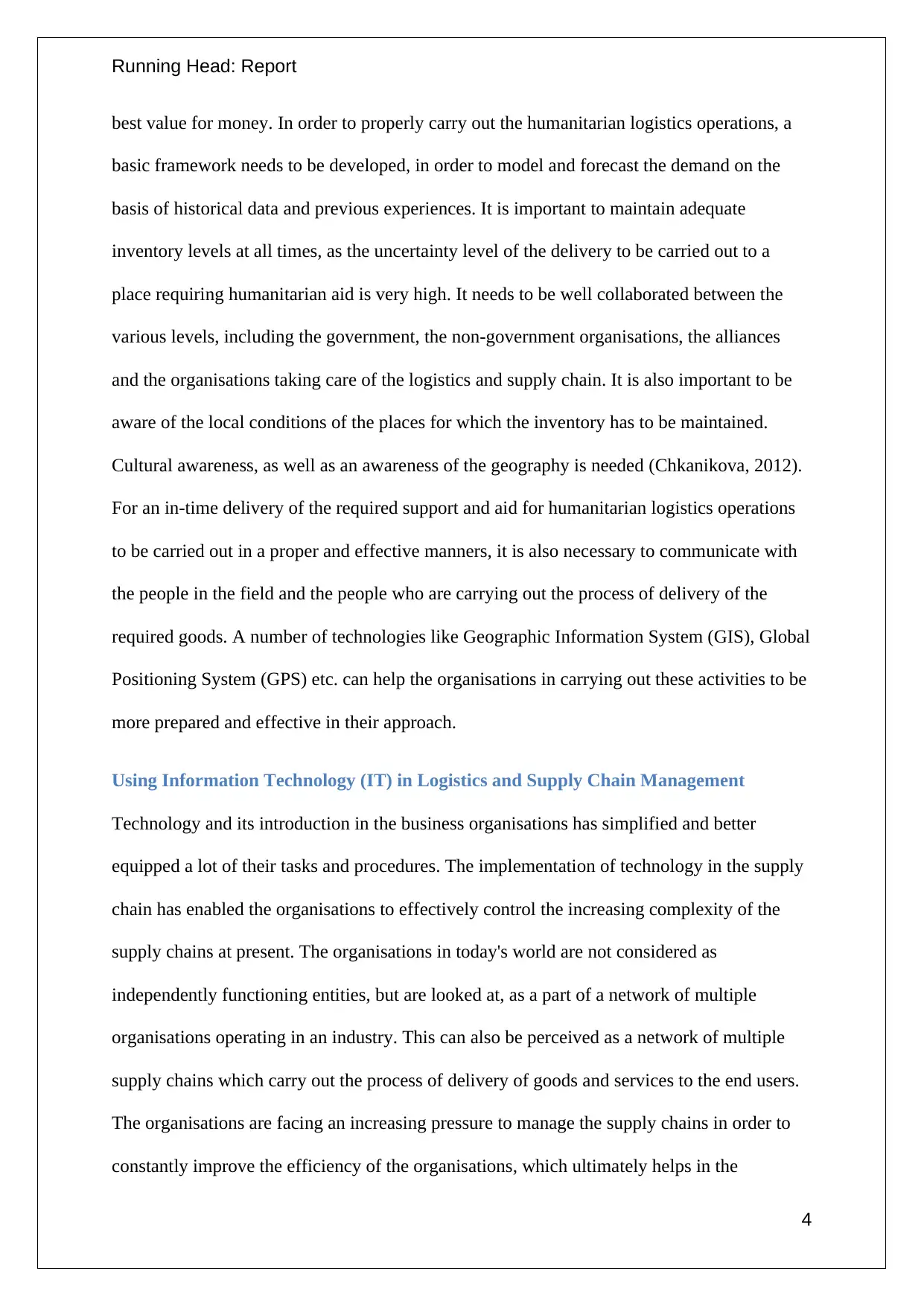
Running Head: Report
best value for money. In order to properly carry out the humanitarian logistics operations, a
basic framework needs to be developed, in order to model and forecast the demand on the
basis of historical data and previous experiences. It is important to maintain adequate
inventory levels at all times, as the uncertainty level of the delivery to be carried out to a
place requiring humanitarian aid is very high. It needs to be well collaborated between the
various levels, including the government, the non-government organisations, the alliances
and the organisations taking care of the logistics and supply chain. It is also important to be
aware of the local conditions of the places for which the inventory has to be maintained.
Cultural awareness, as well as an awareness of the geography is needed (Chkanikova, 2012).
For an in-time delivery of the required support and aid for humanitarian logistics operations
to be carried out in a proper and effective manners, it is also necessary to communicate with
the people in the field and the people who are carrying out the process of delivery of the
required goods. A number of technologies like Geographic Information System (GIS), Global
Positioning System (GPS) etc. can help the organisations in carrying out these activities to be
more prepared and effective in their approach.
Using Information Technology (IT) in Logistics and Supply Chain Management
Technology and its introduction in the business organisations has simplified and better
equipped a lot of their tasks and procedures. The implementation of technology in the supply
chain has enabled the organisations to effectively control the increasing complexity of the
supply chains at present. The organisations in today's world are not considered as
independently functioning entities, but are looked at, as a part of a network of multiple
organisations operating in an industry. This can also be perceived as a network of multiple
supply chains which carry out the process of delivery of goods and services to the end users.
The organisations are facing an increasing pressure to manage the supply chains in order to
constantly improve the efficiency of the organisations, which ultimately helps in the
4
best value for money. In order to properly carry out the humanitarian logistics operations, a
basic framework needs to be developed, in order to model and forecast the demand on the
basis of historical data and previous experiences. It is important to maintain adequate
inventory levels at all times, as the uncertainty level of the delivery to be carried out to a
place requiring humanitarian aid is very high. It needs to be well collaborated between the
various levels, including the government, the non-government organisations, the alliances
and the organisations taking care of the logistics and supply chain. It is also important to be
aware of the local conditions of the places for which the inventory has to be maintained.
Cultural awareness, as well as an awareness of the geography is needed (Chkanikova, 2012).
For an in-time delivery of the required support and aid for humanitarian logistics operations
to be carried out in a proper and effective manners, it is also necessary to communicate with
the people in the field and the people who are carrying out the process of delivery of the
required goods. A number of technologies like Geographic Information System (GIS), Global
Positioning System (GPS) etc. can help the organisations in carrying out these activities to be
more prepared and effective in their approach.
Using Information Technology (IT) in Logistics and Supply Chain Management
Technology and its introduction in the business organisations has simplified and better
equipped a lot of their tasks and procedures. The implementation of technology in the supply
chain has enabled the organisations to effectively control the increasing complexity of the
supply chains at present. The organisations in today's world are not considered as
independently functioning entities, but are looked at, as a part of a network of multiple
organisations operating in an industry. This can also be perceived as a network of multiple
supply chains which carry out the process of delivery of goods and services to the end users.
The organisations are facing an increasing pressure to manage the supply chains in order to
constantly improve the efficiency of the organisations, which ultimately helps in the
4
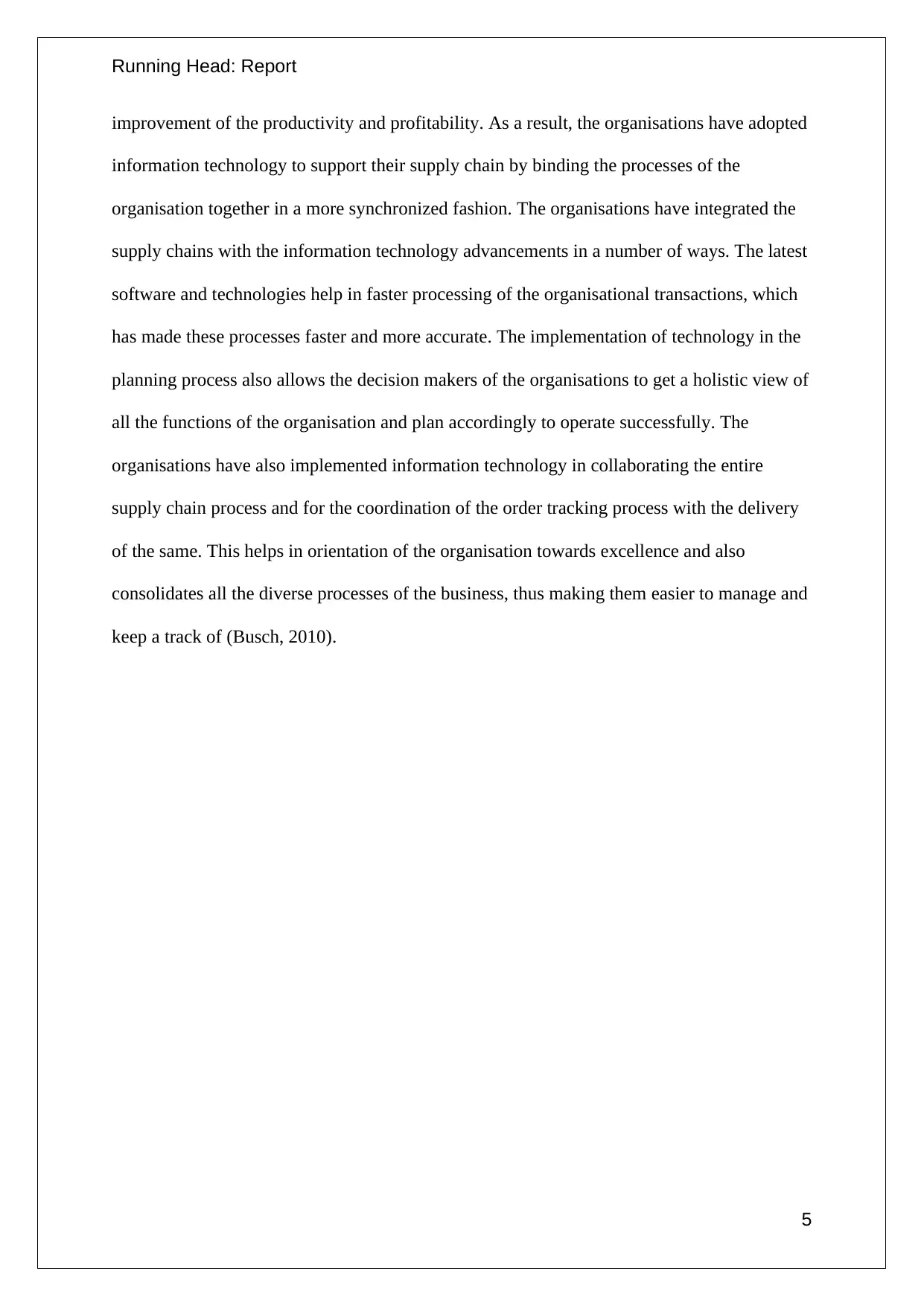
Running Head: Report
improvement of the productivity and profitability. As a result, the organisations have adopted
information technology to support their supply chain by binding the processes of the
organisation together in a more synchronized fashion. The organisations have integrated the
supply chains with the information technology advancements in a number of ways. The latest
software and technologies help in faster processing of the organisational transactions, which
has made these processes faster and more accurate. The implementation of technology in the
planning process also allows the decision makers of the organisations to get a holistic view of
all the functions of the organisation and plan accordingly to operate successfully. The
organisations have also implemented information technology in collaborating the entire
supply chain process and for the coordination of the order tracking process with the delivery
of the same. This helps in orientation of the organisation towards excellence and also
consolidates all the diverse processes of the business, thus making them easier to manage and
keep a track of (Busch, 2010).
5
improvement of the productivity and profitability. As a result, the organisations have adopted
information technology to support their supply chain by binding the processes of the
organisation together in a more synchronized fashion. The organisations have integrated the
supply chains with the information technology advancements in a number of ways. The latest
software and technologies help in faster processing of the organisational transactions, which
has made these processes faster and more accurate. The implementation of technology in the
planning process also allows the decision makers of the organisations to get a holistic view of
all the functions of the organisation and plan accordingly to operate successfully. The
organisations have also implemented information technology in collaborating the entire
supply chain process and for the coordination of the order tracking process with the delivery
of the same. This helps in orientation of the organisation towards excellence and also
consolidates all the diverse processes of the business, thus making them easier to manage and
keep a track of (Busch, 2010).
5
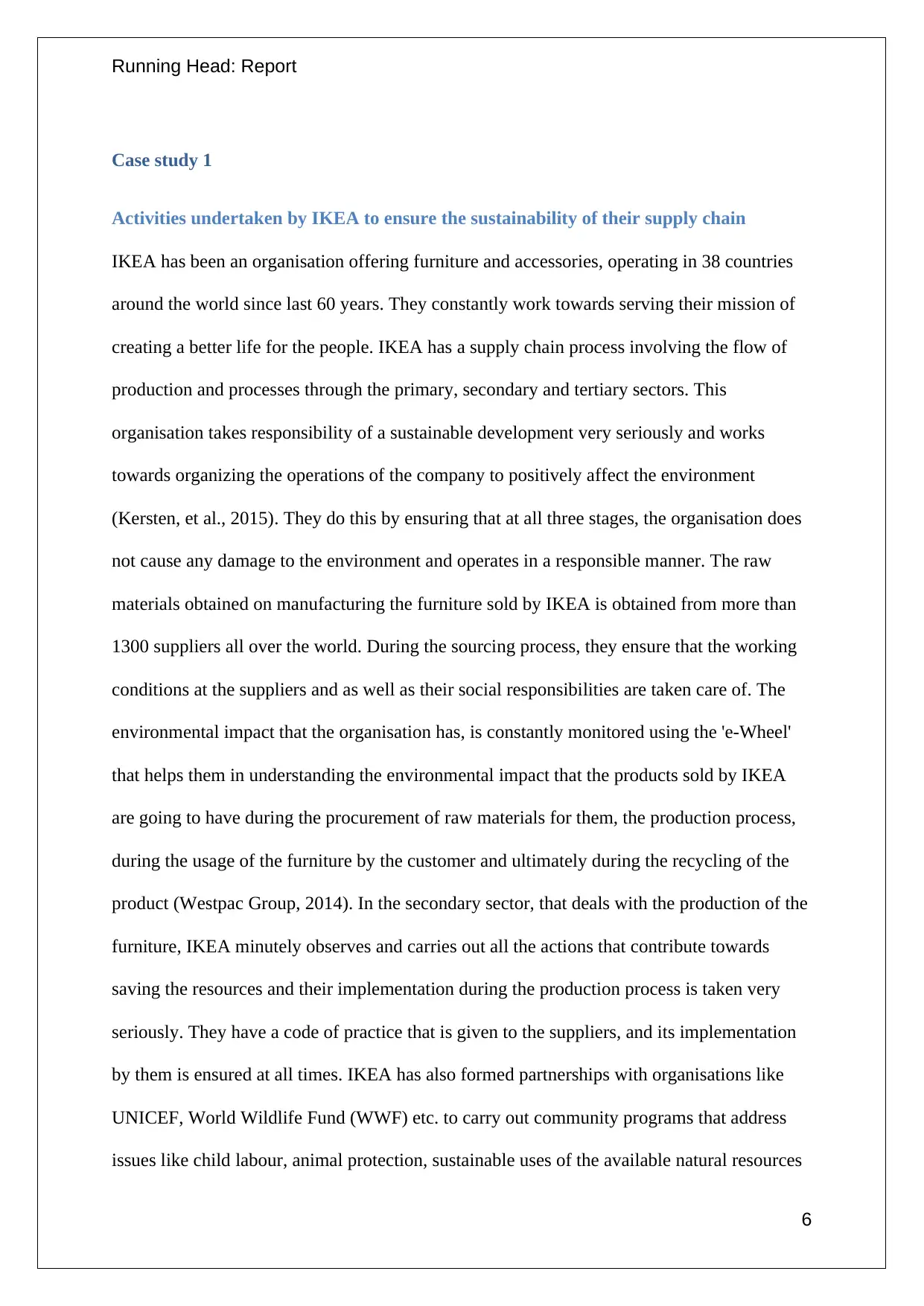
Running Head: Report
Case study 1
Activities undertaken by IKEA to ensure the sustainability of their supply chain
IKEA has been an organisation offering furniture and accessories, operating in 38 countries
around the world since last 60 years. They constantly work towards serving their mission of
creating a better life for the people. IKEA has a supply chain process involving the flow of
production and processes through the primary, secondary and tertiary sectors. This
organisation takes responsibility of a sustainable development very seriously and works
towards organizing the operations of the company to positively affect the environment
(Kersten, et al., 2015). They do this by ensuring that at all three stages, the organisation does
not cause any damage to the environment and operates in a responsible manner. The raw
materials obtained on manufacturing the furniture sold by IKEA is obtained from more than
1300 suppliers all over the world. During the sourcing process, they ensure that the working
conditions at the suppliers and as well as their social responsibilities are taken care of. The
environmental impact that the organisation has, is constantly monitored using the 'e-Wheel'
that helps them in understanding the environmental impact that the products sold by IKEA
are going to have during the procurement of raw materials for them, the production process,
during the usage of the furniture by the customer and ultimately during the recycling of the
product (Westpac Group, 2014). In the secondary sector, that deals with the production of the
furniture, IKEA minutely observes and carries out all the actions that contribute towards
saving the resources and their implementation during the production process is taken very
seriously. They have a code of practice that is given to the suppliers, and its implementation
by them is ensured at all times. IKEA has also formed partnerships with organisations like
UNICEF, World Wildlife Fund (WWF) etc. to carry out community programs that address
issues like child labour, animal protection, sustainable uses of the available natural resources
6
Case study 1
Activities undertaken by IKEA to ensure the sustainability of their supply chain
IKEA has been an organisation offering furniture and accessories, operating in 38 countries
around the world since last 60 years. They constantly work towards serving their mission of
creating a better life for the people. IKEA has a supply chain process involving the flow of
production and processes through the primary, secondary and tertiary sectors. This
organisation takes responsibility of a sustainable development very seriously and works
towards organizing the operations of the company to positively affect the environment
(Kersten, et al., 2015). They do this by ensuring that at all three stages, the organisation does
not cause any damage to the environment and operates in a responsible manner. The raw
materials obtained on manufacturing the furniture sold by IKEA is obtained from more than
1300 suppliers all over the world. During the sourcing process, they ensure that the working
conditions at the suppliers and as well as their social responsibilities are taken care of. The
environmental impact that the organisation has, is constantly monitored using the 'e-Wheel'
that helps them in understanding the environmental impact that the products sold by IKEA
are going to have during the procurement of raw materials for them, the production process,
during the usage of the furniture by the customer and ultimately during the recycling of the
product (Westpac Group, 2014). In the secondary sector, that deals with the production of the
furniture, IKEA minutely observes and carries out all the actions that contribute towards
saving the resources and their implementation during the production process is taken very
seriously. They have a code of practice that is given to the suppliers, and its implementation
by them is ensured at all times. IKEA has also formed partnerships with organisations like
UNICEF, World Wildlife Fund (WWF) etc. to carry out community programs that address
issues like child labour, animal protection, sustainable uses of the available natural resources
6
Paraphrase This Document
Need a fresh take? Get an instant paraphrase of this document with our AI Paraphraser
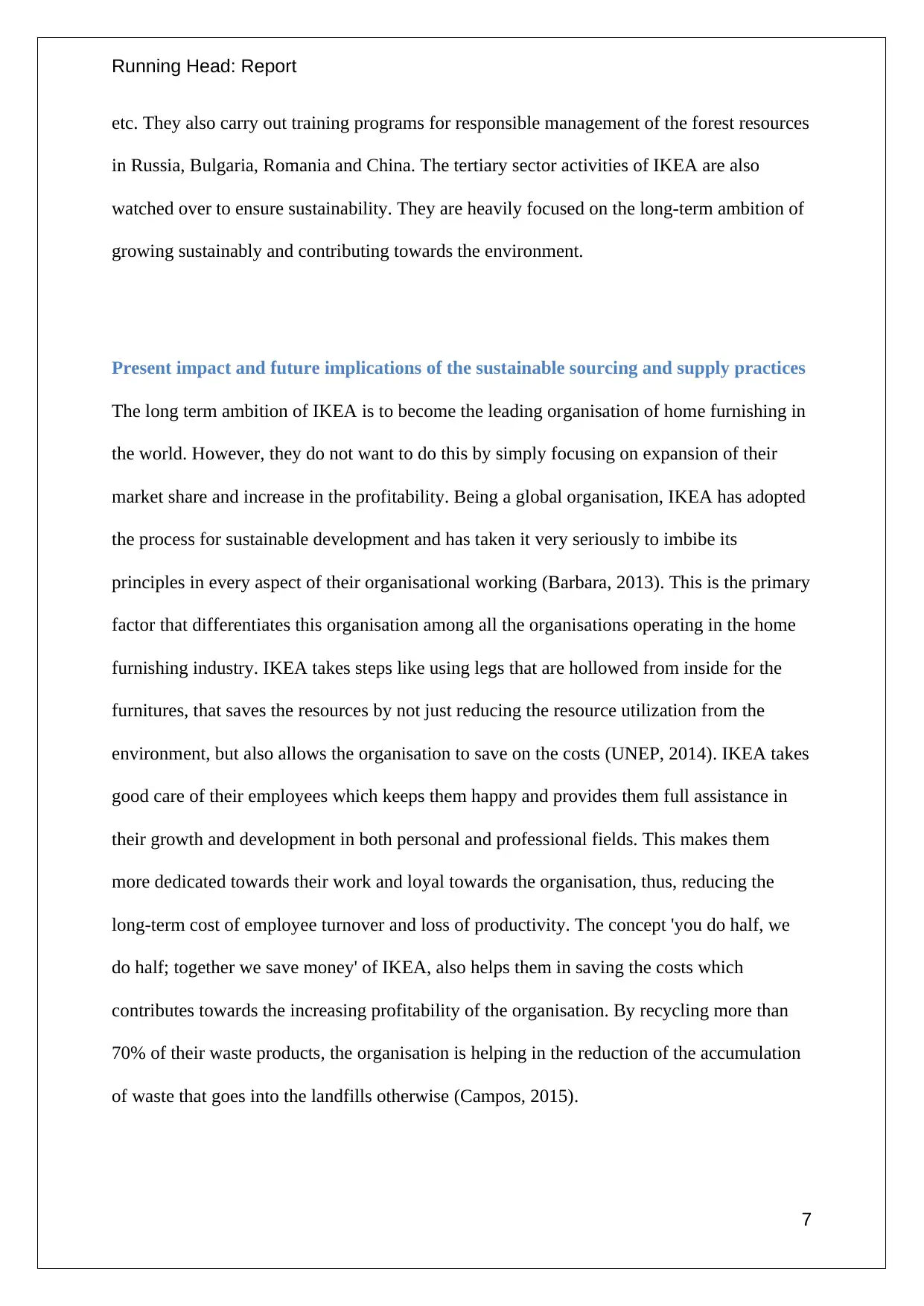
Running Head: Report
etc. They also carry out training programs for responsible management of the forest resources
in Russia, Bulgaria, Romania and China. The tertiary sector activities of IKEA are also
watched over to ensure sustainability. They are heavily focused on the long-term ambition of
growing sustainably and contributing towards the environment.
Present impact and future implications of the sustainable sourcing and supply practices
The long term ambition of IKEA is to become the leading organisation of home furnishing in
the world. However, they do not want to do this by simply focusing on expansion of their
market share and increase in the profitability. Being a global organisation, IKEA has adopted
the process for sustainable development and has taken it very seriously to imbibe its
principles in every aspect of their organisational working (Barbara, 2013). This is the primary
factor that differentiates this organisation among all the organisations operating in the home
furnishing industry. IKEA takes steps like using legs that are hollowed from inside for the
furnitures, that saves the resources by not just reducing the resource utilization from the
environment, but also allows the organisation to save on the costs (UNEP, 2014). IKEA takes
good care of their employees which keeps them happy and provides them full assistance in
their growth and development in both personal and professional fields. This makes them
more dedicated towards their work and loyal towards the organisation, thus, reducing the
long-term cost of employee turnover and loss of productivity. The concept 'you do half, we
do half; together we save money' of IKEA, also helps them in saving the costs which
contributes towards the increasing profitability of the organisation. By recycling more than
70% of their waste products, the organisation is helping in the reduction of the accumulation
of waste that goes into the landfills otherwise (Campos, 2015).
7
etc. They also carry out training programs for responsible management of the forest resources
in Russia, Bulgaria, Romania and China. The tertiary sector activities of IKEA are also
watched over to ensure sustainability. They are heavily focused on the long-term ambition of
growing sustainably and contributing towards the environment.
Present impact and future implications of the sustainable sourcing and supply practices
The long term ambition of IKEA is to become the leading organisation of home furnishing in
the world. However, they do not want to do this by simply focusing on expansion of their
market share and increase in the profitability. Being a global organisation, IKEA has adopted
the process for sustainable development and has taken it very seriously to imbibe its
principles in every aspect of their organisational working (Barbara, 2013). This is the primary
factor that differentiates this organisation among all the organisations operating in the home
furnishing industry. IKEA takes steps like using legs that are hollowed from inside for the
furnitures, that saves the resources by not just reducing the resource utilization from the
environment, but also allows the organisation to save on the costs (UNEP, 2014). IKEA takes
good care of their employees which keeps them happy and provides them full assistance in
their growth and development in both personal and professional fields. This makes them
more dedicated towards their work and loyal towards the organisation, thus, reducing the
long-term cost of employee turnover and loss of productivity. The concept 'you do half, we
do half; together we save money' of IKEA, also helps them in saving the costs which
contributes towards the increasing profitability of the organisation. By recycling more than
70% of their waste products, the organisation is helping in the reduction of the accumulation
of waste that goes into the landfills otherwise (Campos, 2015).
7
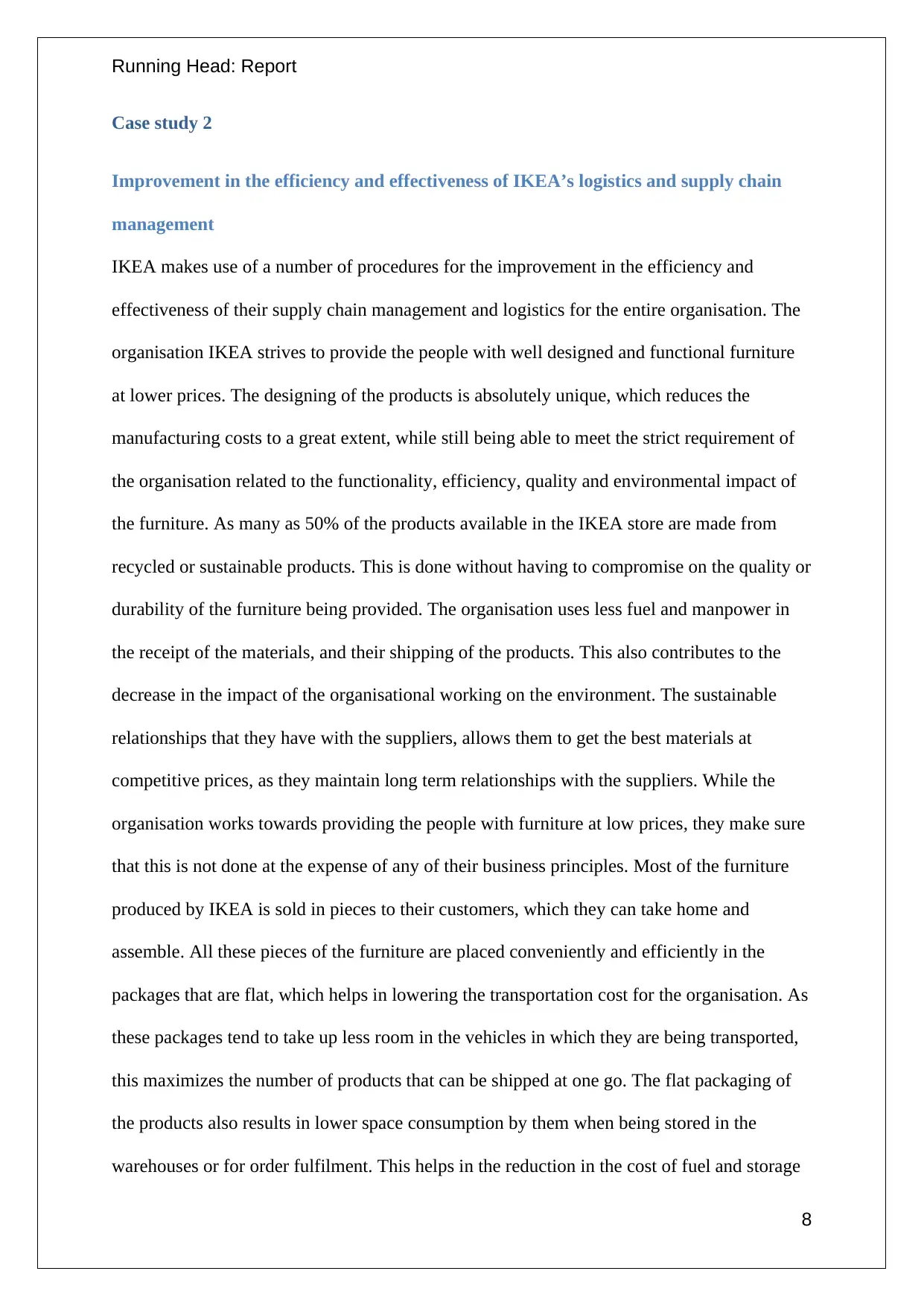
Running Head: Report
Case study 2
Improvement in the efficiency and effectiveness of IKEA’s logistics and supply chain
management
IKEA makes use of a number of procedures for the improvement in the efficiency and
effectiveness of their supply chain management and logistics for the entire organisation. The
organisation IKEA strives to provide the people with well designed and functional furniture
at lower prices. The designing of the products is absolutely unique, which reduces the
manufacturing costs to a great extent, while still being able to meet the strict requirement of
the organisation related to the functionality, efficiency, quality and environmental impact of
the furniture. As many as 50% of the products available in the IKEA store are made from
recycled or sustainable products. This is done without having to compromise on the quality or
durability of the furniture being provided. The organisation uses less fuel and manpower in
the receipt of the materials, and their shipping of the products. This also contributes to the
decrease in the impact of the organisational working on the environment. The sustainable
relationships that they have with the suppliers, allows them to get the best materials at
competitive prices, as they maintain long term relationships with the suppliers. While the
organisation works towards providing the people with furniture at low prices, they make sure
that this is not done at the expense of any of their business principles. Most of the furniture
produced by IKEA is sold in pieces to their customers, which they can take home and
assemble. All these pieces of the furniture are placed conveniently and efficiently in the
packages that are flat, which helps in lowering the transportation cost for the organisation. As
these packages tend to take up less room in the vehicles in which they are being transported,
this maximizes the number of products that can be shipped at one go. The flat packaging of
the products also results in lower space consumption by them when being stored in the
warehouses or for order fulfilment. This helps in the reduction in the cost of fuel and storage
8
Case study 2
Improvement in the efficiency and effectiveness of IKEA’s logistics and supply chain
management
IKEA makes use of a number of procedures for the improvement in the efficiency and
effectiveness of their supply chain management and logistics for the entire organisation. The
organisation IKEA strives to provide the people with well designed and functional furniture
at lower prices. The designing of the products is absolutely unique, which reduces the
manufacturing costs to a great extent, while still being able to meet the strict requirement of
the organisation related to the functionality, efficiency, quality and environmental impact of
the furniture. As many as 50% of the products available in the IKEA store are made from
recycled or sustainable products. This is done without having to compromise on the quality or
durability of the furniture being provided. The organisation uses less fuel and manpower in
the receipt of the materials, and their shipping of the products. This also contributes to the
decrease in the impact of the organisational working on the environment. The sustainable
relationships that they have with the suppliers, allows them to get the best materials at
competitive prices, as they maintain long term relationships with the suppliers. While the
organisation works towards providing the people with furniture at low prices, they make sure
that this is not done at the expense of any of their business principles. Most of the furniture
produced by IKEA is sold in pieces to their customers, which they can take home and
assemble. All these pieces of the furniture are placed conveniently and efficiently in the
packages that are flat, which helps in lowering the transportation cost for the organisation. As
these packages tend to take up less room in the vehicles in which they are being transported,
this maximizes the number of products that can be shipped at one go. The flat packaging of
the products also results in lower space consumption by them when being stored in the
warehouses or for order fulfilment. This helps in the reduction in the cost of fuel and storage
8
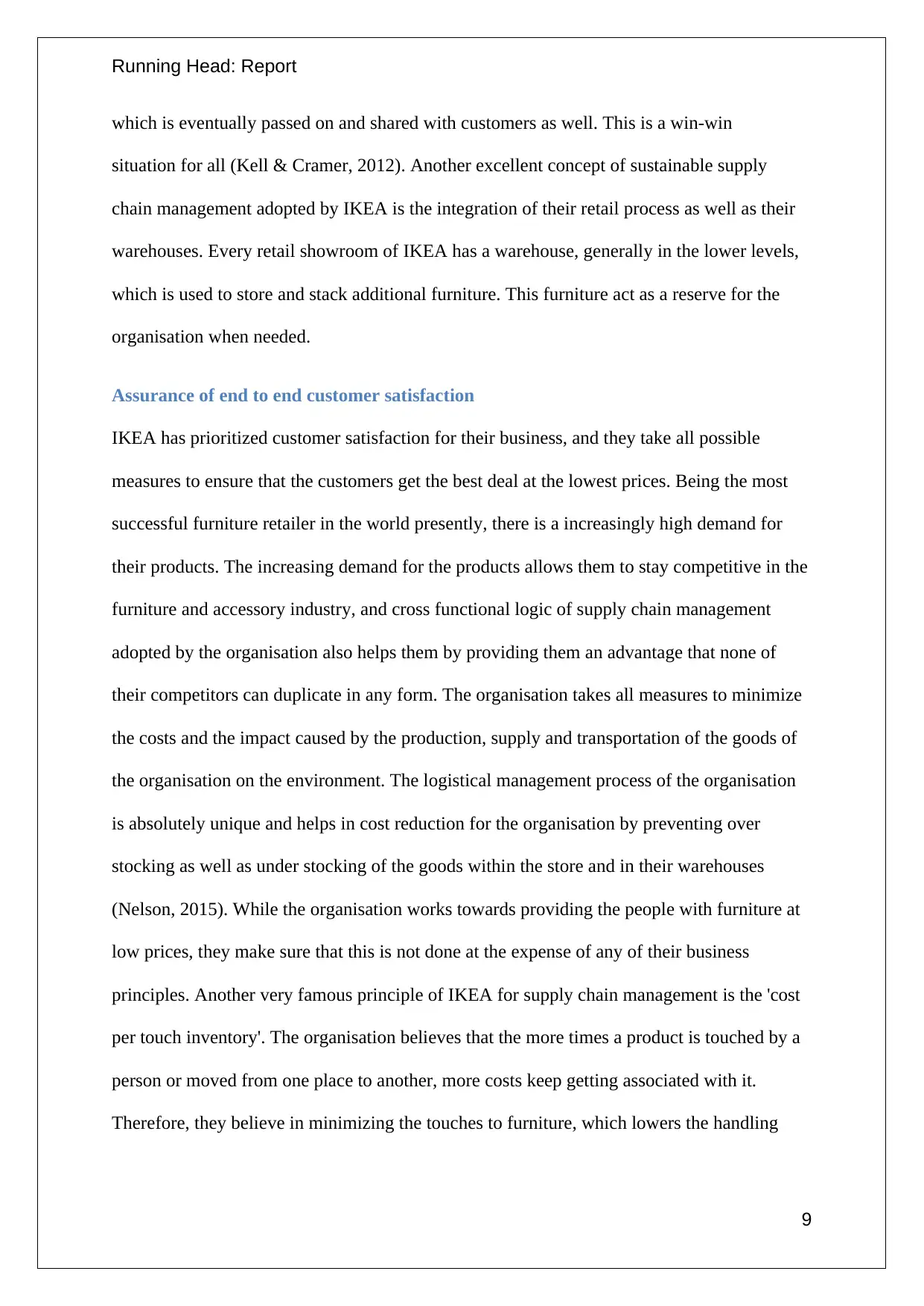
Running Head: Report
which is eventually passed on and shared with customers as well. This is a win-win
situation for all (Kell & Cramer, 2012). Another excellent concept of sustainable supply
chain management adopted by IKEA is the integration of their retail process as well as their
warehouses. Every retail showroom of IKEA has a warehouse, generally in the lower levels,
which is used to store and stack additional furniture. This furniture act as a reserve for the
organisation when needed.
Assurance of end to end customer satisfaction
IKEA has prioritized customer satisfaction for their business, and they take all possible
measures to ensure that the customers get the best deal at the lowest prices. Being the most
successful furniture retailer in the world presently, there is a increasingly high demand for
their products. The increasing demand for the products allows them to stay competitive in the
furniture and accessory industry, and cross functional logic of supply chain management
adopted by the organisation also helps them by providing them an advantage that none of
their competitors can duplicate in any form. The organisation takes all measures to minimize
the costs and the impact caused by the production, supply and transportation of the goods of
the organisation on the environment. The logistical management process of the organisation
is absolutely unique and helps in cost reduction for the organisation by preventing over
stocking as well as under stocking of the goods within the store and in their warehouses
(Nelson, 2015). While the organisation works towards providing the people with furniture at
low prices, they make sure that this is not done at the expense of any of their business
principles. Another very famous principle of IKEA for supply chain management is the 'cost
per touch inventory'. The organisation believes that the more times a product is touched by a
person or moved from one place to another, more costs keep getting associated with it.
Therefore, they believe in minimizing the touches to furniture, which lowers the handling
9
which is eventually passed on and shared with customers as well. This is a win-win
situation for all (Kell & Cramer, 2012). Another excellent concept of sustainable supply
chain management adopted by IKEA is the integration of their retail process as well as their
warehouses. Every retail showroom of IKEA has a warehouse, generally in the lower levels,
which is used to store and stack additional furniture. This furniture act as a reserve for the
organisation when needed.
Assurance of end to end customer satisfaction
IKEA has prioritized customer satisfaction for their business, and they take all possible
measures to ensure that the customers get the best deal at the lowest prices. Being the most
successful furniture retailer in the world presently, there is a increasingly high demand for
their products. The increasing demand for the products allows them to stay competitive in the
furniture and accessory industry, and cross functional logic of supply chain management
adopted by the organisation also helps them by providing them an advantage that none of
their competitors can duplicate in any form. The organisation takes all measures to minimize
the costs and the impact caused by the production, supply and transportation of the goods of
the organisation on the environment. The logistical management process of the organisation
is absolutely unique and helps in cost reduction for the organisation by preventing over
stocking as well as under stocking of the goods within the store and in their warehouses
(Nelson, 2015). While the organisation works towards providing the people with furniture at
low prices, they make sure that this is not done at the expense of any of their business
principles. Another very famous principle of IKEA for supply chain management is the 'cost
per touch inventory'. The organisation believes that the more times a product is touched by a
person or moved from one place to another, more costs keep getting associated with it.
Therefore, they believe in minimizing the touches to furniture, which lowers the handling
9
Secure Best Marks with AI Grader
Need help grading? Try our AI Grader for instant feedback on your assignments.
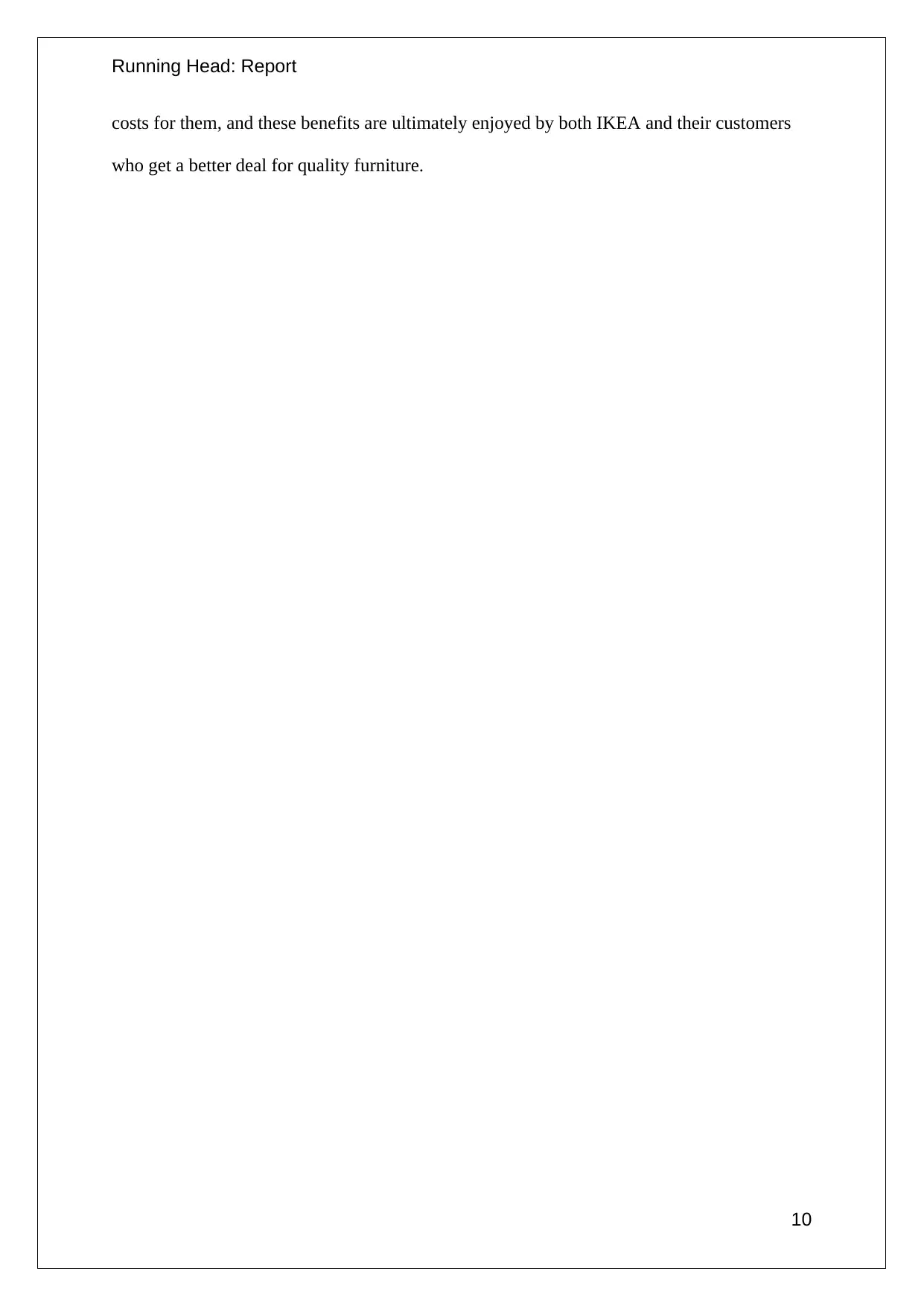
Running Head: Report
costs for them, and these benefits are ultimately enjoyed by both IKEA and their customers
who get a better deal for quality furniture.
10
costs for them, and these benefits are ultimately enjoyed by both IKEA and their customers
who get a better deal for quality furniture.
10
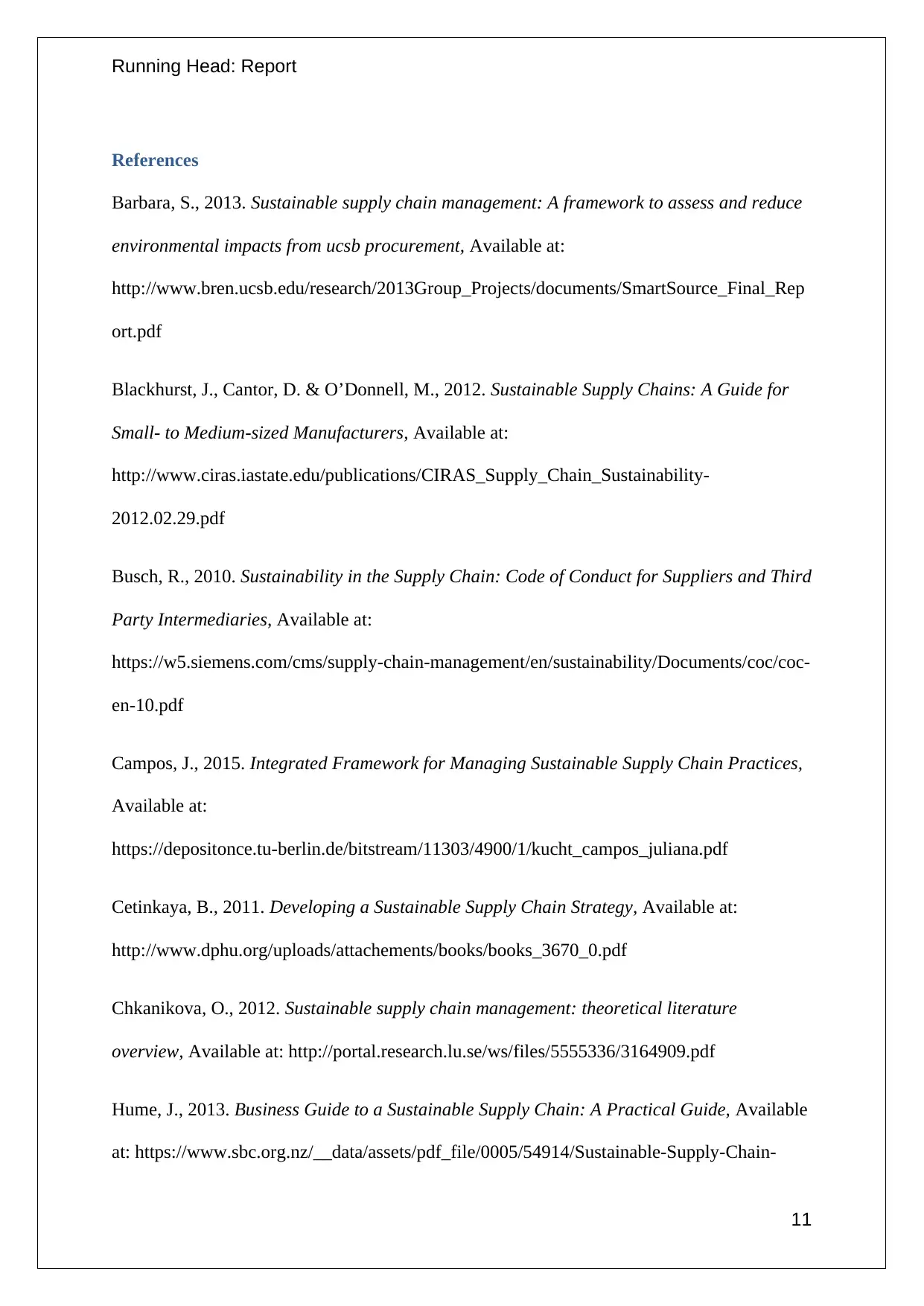
Running Head: Report
References
Barbara, S., 2013. Sustainable supply chain management: A framework to assess and reduce
environmental impacts from ucsb procurement, Available at:
http://www.bren.ucsb.edu/research/2013Group_Projects/documents/SmartSource_Final_Rep
ort.pdf
Blackhurst, J., Cantor, D. & O’Donnell, M., 2012. Sustainable Supply Chains: A Guide for
Small- to Medium-sized Manufacturers, Available at:
http://www.ciras.iastate.edu/publications/CIRAS_Supply_Chain_Sustainability-
2012.02.29.pdf
Busch, R., 2010. Sustainability in the Supply Chain: Code of Conduct for Suppliers and Third
Party Intermediaries, Available at:
https://w5.siemens.com/cms/supply-chain-management/en/sustainability/Documents/coc/coc-
en-10.pdf
Campos, J., 2015. Integrated Framework for Managing Sustainable Supply Chain Practices,
Available at:
https://depositonce.tu-berlin.de/bitstream/11303/4900/1/kucht_campos_juliana.pdf
Cetinkaya, B., 2011. Developing a Sustainable Supply Chain Strategy, Available at:
http://www.dphu.org/uploads/attachements/books/books_3670_0.pdf
Chkanikova, O., 2012. Sustainable supply chain management: theoretical literature
overview, Available at: http://portal.research.lu.se/ws/files/5555336/3164909.pdf
Hume, J., 2013. Business Guide to a Sustainable Supply Chain: A Practical Guide, Available
at: https://www.sbc.org.nz/__data/assets/pdf_file/0005/54914/Sustainable-Supply-Chain-
11
References
Barbara, S., 2013. Sustainable supply chain management: A framework to assess and reduce
environmental impacts from ucsb procurement, Available at:
http://www.bren.ucsb.edu/research/2013Group_Projects/documents/SmartSource_Final_Rep
ort.pdf
Blackhurst, J., Cantor, D. & O’Donnell, M., 2012. Sustainable Supply Chains: A Guide for
Small- to Medium-sized Manufacturers, Available at:
http://www.ciras.iastate.edu/publications/CIRAS_Supply_Chain_Sustainability-
2012.02.29.pdf
Busch, R., 2010. Sustainability in the Supply Chain: Code of Conduct for Suppliers and Third
Party Intermediaries, Available at:
https://w5.siemens.com/cms/supply-chain-management/en/sustainability/Documents/coc/coc-
en-10.pdf
Campos, J., 2015. Integrated Framework for Managing Sustainable Supply Chain Practices,
Available at:
https://depositonce.tu-berlin.de/bitstream/11303/4900/1/kucht_campos_juliana.pdf
Cetinkaya, B., 2011. Developing a Sustainable Supply Chain Strategy, Available at:
http://www.dphu.org/uploads/attachements/books/books_3670_0.pdf
Chkanikova, O., 2012. Sustainable supply chain management: theoretical literature
overview, Available at: http://portal.research.lu.se/ws/files/5555336/3164909.pdf
Hume, J., 2013. Business Guide to a Sustainable Supply Chain: A Practical Guide, Available
at: https://www.sbc.org.nz/__data/assets/pdf_file/0005/54914/Sustainable-Supply-Chain-
11
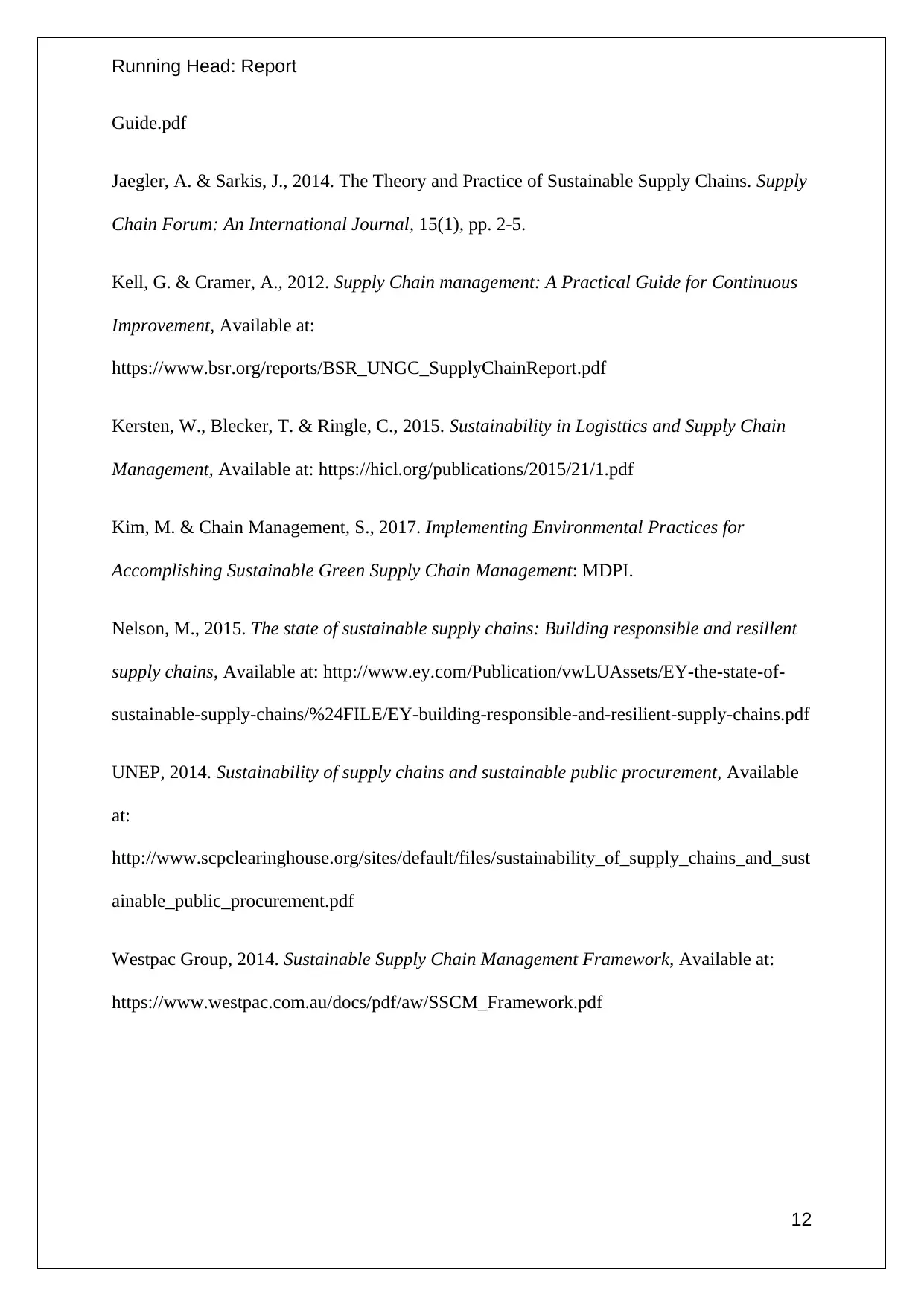
Running Head: Report
Guide.pdf
Jaegler, A. & Sarkis, J., 2014. The Theory and Practice of Sustainable Supply Chains. Supply
Chain Forum: An International Journal, 15(1), pp. 2-5.
Kell, G. & Cramer, A., 2012. Supply Chain management: A Practical Guide for Continuous
Improvement, Available at:
https://www.bsr.org/reports/BSR_UNGC_SupplyChainReport.pdf
Kersten, W., Blecker, T. & Ringle, C., 2015. Sustainability in Logisttics and Supply Chain
Management, Available at: https://hicl.org/publications/2015/21/1.pdf
Kim, M. & Chain Management, S., 2017. Implementing Environmental Practices for
Accomplishing Sustainable Green Supply Chain Management: MDPI.
Nelson, M., 2015. The state of sustainable supply chains: Building responsible and resillent
supply chains, Available at: http://www.ey.com/Publication/vwLUAssets/EY-the-state-of-
sustainable-supply-chains/%24FILE/EY-building-responsible-and-resilient-supply-chains.pdf
UNEP, 2014. Sustainability of supply chains and sustainable public procurement, Available
at:
http://www.scpclearinghouse.org/sites/default/files/sustainability_of_supply_chains_and_sust
ainable_public_procurement.pdf
Westpac Group, 2014. Sustainable Supply Chain Management Framework, Available at:
https://www.westpac.com.au/docs/pdf/aw/SSCM_Framework.pdf
12
Guide.pdf
Jaegler, A. & Sarkis, J., 2014. The Theory and Practice of Sustainable Supply Chains. Supply
Chain Forum: An International Journal, 15(1), pp. 2-5.
Kell, G. & Cramer, A., 2012. Supply Chain management: A Practical Guide for Continuous
Improvement, Available at:
https://www.bsr.org/reports/BSR_UNGC_SupplyChainReport.pdf
Kersten, W., Blecker, T. & Ringle, C., 2015. Sustainability in Logisttics and Supply Chain
Management, Available at: https://hicl.org/publications/2015/21/1.pdf
Kim, M. & Chain Management, S., 2017. Implementing Environmental Practices for
Accomplishing Sustainable Green Supply Chain Management: MDPI.
Nelson, M., 2015. The state of sustainable supply chains: Building responsible and resillent
supply chains, Available at: http://www.ey.com/Publication/vwLUAssets/EY-the-state-of-
sustainable-supply-chains/%24FILE/EY-building-responsible-and-resilient-supply-chains.pdf
UNEP, 2014. Sustainability of supply chains and sustainable public procurement, Available
at:
http://www.scpclearinghouse.org/sites/default/files/sustainability_of_supply_chains_and_sust
ainable_public_procurement.pdf
Westpac Group, 2014. Sustainable Supply Chain Management Framework, Available at:
https://www.westpac.com.au/docs/pdf/aw/SSCM_Framework.pdf
12
1 out of 13
Related Documents
Your All-in-One AI-Powered Toolkit for Academic Success.
+13062052269
info@desklib.com
Available 24*7 on WhatsApp / Email
![[object Object]](/_next/static/media/star-bottom.7253800d.svg)
Unlock your academic potential
© 2024 | Zucol Services PVT LTD | All rights reserved.





